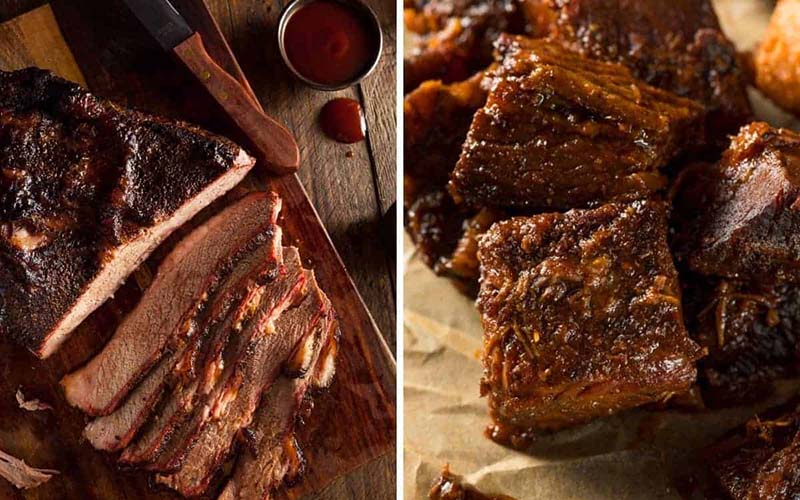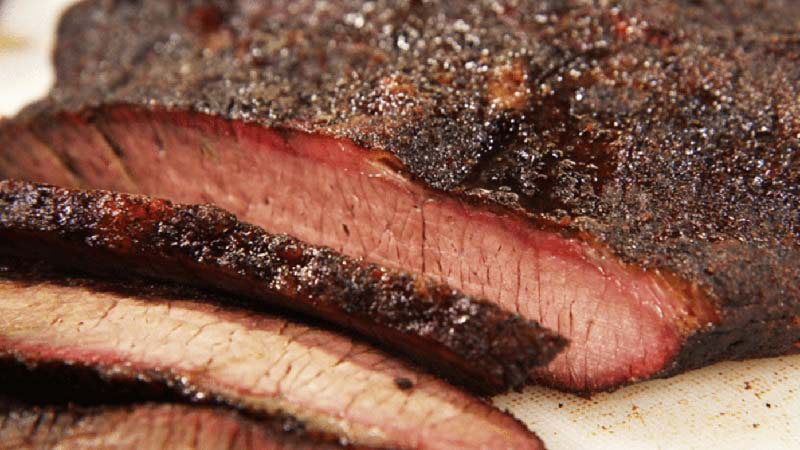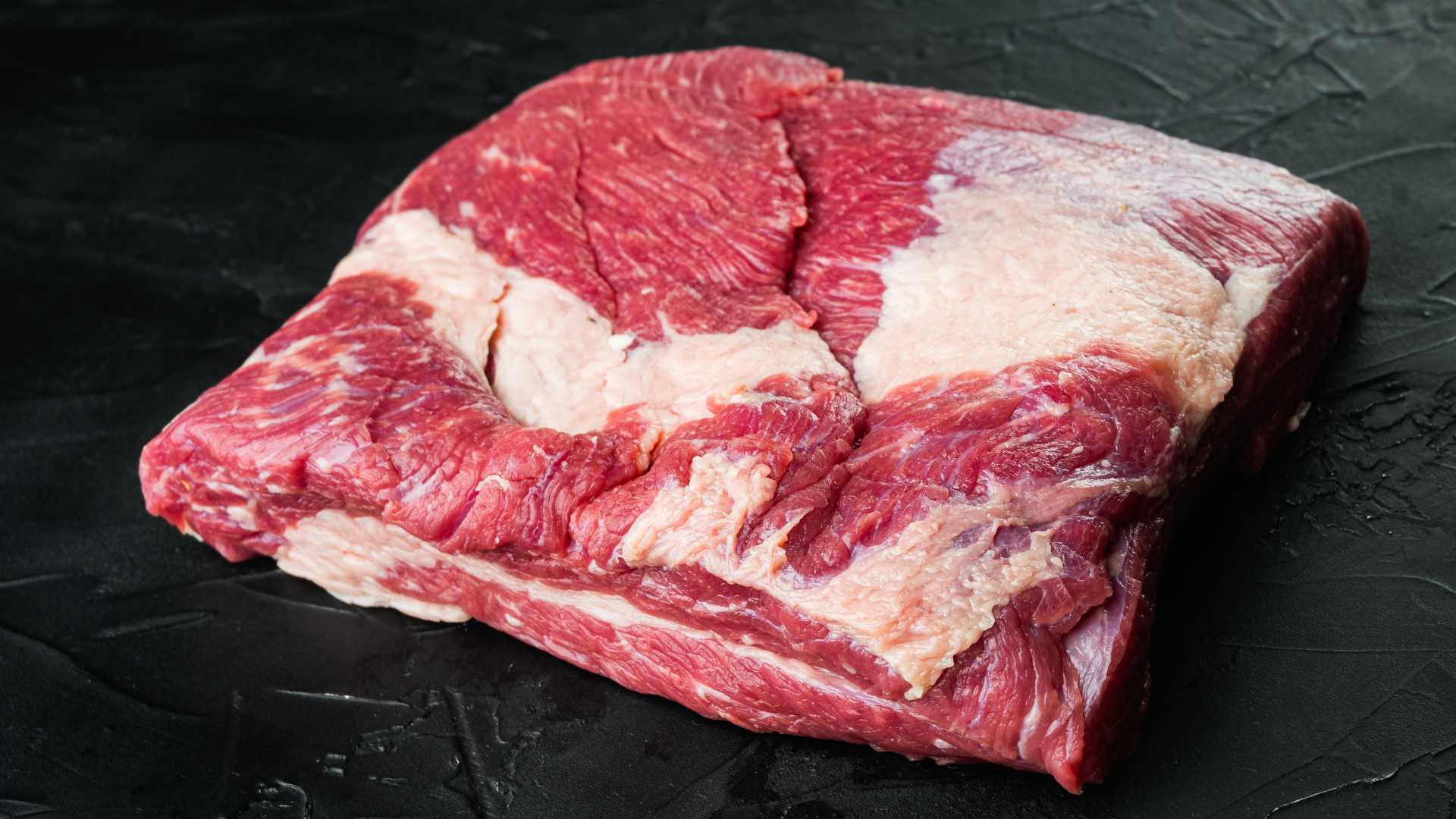Brisket is a highly sought-after cut of beef that is widely used in many traditional cooking methods such as barbecuing, smoking, and slow cooking. There are two main types of brisket cuts available: the brisket flat and the brisket point.
While both cuts are from the same part of the cow, the brisket, they differ significantly in terms of their texture, fat content, and cooking requirements.
In this article, we will compare and contrast the brisket flat and the brisket point, exploring their unique characteristics and providing tips on how to choose the right brisket cut for your next BBQ or slow-cooking adventure.
Definition of Brisket Flat and Point
The brisket flat is a large, rectangular cut of meat that is usually between 2-3 pounds in weight. This cut is relatively lean, with a relatively uniform thickness and a tight grain structure. On the other hand, the brisket point is a smaller, triangular cut of meat that is often marbled with pockets of fat. This cut is thicker and has a more irregular shape than the brisket flat, which makes it more challenging to cook evenly.

Importance of Understanding the Differences Between Brisket Flat and Point
When choosing between brisket flat and brisket point, it is essential to understand the differences between the two cuts, as this will help you to select the right cut for your cooking needs. Brisket flat is best for those who prefer leaner cuts of meat, while brisket point is best for those who prefer meat with a higher fat content. Additionally, brisket flat is easier to cook evenly, while brisket point requires more attention during the cooking process to ensure that it is cooked to the right temperature and tenderness.
Comparison of Brisket Flat and Point
Characteristics and Characteristics
Size and Shape
The brisket flat is typically larger and more rectangular in shape than the brisket point, making it easier to cook evenly. The brisket point is usually smaller, triangular, and thicker, which can make it more challenging to cook evenly.
Fat Content
The brisket flat is relatively lean, with a relatively uniform thickness and a tight grain structure. This makes it easier to cook evenly, but it can also result in a dryer, less flavorful cut of meat if not cooked correctly. On the other hand, the brisket point is often marbled with pockets of fat, which gives it a more robust flavor and added moisture. This fat content also makes the brisket point more challenging to cook evenly, as it can result in some areas being over or undercooked.
Texture
The brisket flat has a tighter grain structure, which results in a firmer, more tender texture when cooked correctly. The brisket point, on the other hand, has a more irregular shape, which can make it more challenging to cook evenly. This can result in a chewy, less tender texture if not cooked correctly.
Cook Time and Temperature

The brisket flat typically requires a longer cook time at a lower temperature than the brisket point. This is because the brisket flat is leaner and requires more time to break down the connective tissues and achieve a tender texture. Brisket point, on the other hand, requires a shorter cook time at a higher temperature, as the fat content helps to keep the meat moist and tender.
Tenderness and Flavor
When cooked correctly, both brisket flat and brisket point can be incredibly tender and flavorful. However, the brisket point is often considered to have a more robust flavor due to its higher fat content.
Pros and Cons of Brisket Flat and Point
Brisket Flat
Pros:
- A leaner cut of meat
- Even cooking results in a firmer, more tender texture
- Lower calorie and fat content
Cons:
- Can be dry and less flavorful if not cooked correctly
- Longer cook time at a lower temperature is required to break down connective tissues
Brisket Point
Pros:
- Higher fat content results in a more robust flavor
- Shorter cook time at a higher temperature, resulting in a more tender texture
- The added moisture from the fat content helps prevent the meat from drying out
Cons:
- The irregular shape can result in uneven cooking and a less tender texture
- Higher calorie and fat content
How to Choose Between Brisket Flat and Point
Considerations for Selecting the Right Brisket Cut
Purpose of Cooking
When choosing between brisket flat and brisket point, it’s important to consider the purpose of your cooking. If you’re cooking for a leaner, healthier option, brisket flat may be the better choice. On the other hand, if you’re looking for a more flavorful, richly marbled cut of meat, brisket point may be the way to go.
Size of the Gathering
The size of your gathering will also play a role in your choice of brisket cut. If you’re cooking for a large group of people, brisket flat may be the more cost-effective option as it is larger in size. However, if you’re cooking for a smaller gathering, brisket point may be a more suitable option as it is a smaller cut of meat.
Personal Preference
Ultimately, the choice between brisket flat and brisket point comes down to personal preference. Consider your dietary needs and your taste preferences when making your choice.
Tips for Cooking Brisket Flat and Point

When cooking brisket, it’s important to follow the recommended cook time and temperature to achieve the best results. Here are some tips to help you cook the perfect brisket, whether you choose flat or point:
- For brisket flat, cook at a lower temperature for a longer time to break down the connective tissues and achieve a tender texture.
- For brisket point, cook at a higher temperature for a shorter time to ensure that the meat stays tender and juicy.
- When cooking either cut, use a meat thermometer to ensure that the internal temperature of the meat reaches at least 145°F to ensure that it is fully cooked and safe to eat.
- Allow the brisket to rest for at least 15-20 minutes before slicing to allow the juices to redistribute throughout the meat, resulting in a more tender and flavorful brisket.
Conclusion
In conclusion, both brisket flat and brisket point have their unique pros and cons, and the choice between the two ultimately comes down to personal preference and cooking needs. When selecting the right brisket cut, consider the purpose of your cooking, the size of your gathering, and your taste preferences. With the right cooking techniques and the use of a meat thermometer, you can achieve a perfectly cooked, tender, and flavorful brisket every time.
